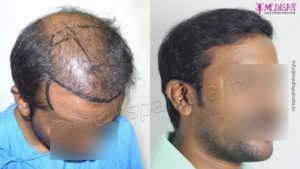What is Graft?
Graft in the hair transplant procedure refers to tissue containing hair follicles that are genetically resistant to the DHT-sensitivity and thus allows the process of the hair transplant to be permanent in nature. There are two methods are accepted in the hair transplant procedure, namely, the FUT hair transplant and the FUE hair transplant. Regardless of extraction technique, the motive of hair transplant surgery is to obtain the feasible number of hair roots/graft to fulfil the need for the hair transplant procedure. This is the graft that is extracted by the hair transplant technique to treat the male as well as the female pattern baldness.
Since hair naturally grows in grouping of 1-4 hairs, termed as the follicular unit and this unit is targeted to harvest via the FUT or the follicular unit transplant method to fulfil the desired restoration goal of the surgery. The grouping of hairs that is ranges 1-4 is termed as follicular unit contains grafts or hair roots that are actually transplanted into the recipient balding part of the scalp followed by the proper dissection process under the higher magnification of microscopes. However, Grafts decide the procedure of hair transplant in terms of actual requirement to meet the demand of the surgery.
The Graft Calculator:
The graft calculator actually decides the needed number of grafts/hair roots per square centimetre in the balding areas. There is graft calculator that explains the actual requirement of the graft for the particular grade of baldness.
https://www.medispaindia.in/hair-calculator/
The Graft Extraction in the FUT/Strip Method of the Surgery:
The graft extraction in the follicular unit transplant (FUT) has continued to evolve, becoming more refined and minimally invasive as the incision made for the strip excision have become smaller with as aesthetic depth and length. There is more chance for graft survival rate in the FUT technique due to microscopic dissection. The higher magnification of microscopes allows a surgeon to obtain the best possible number of viable grafts as each graft separated carefully under the higher magnification of microscopes.
The modern era FUT technique with lateral slit enabled surgeons to orient 2-4 hair follicular unit grafts so that they splay out across the scalp surface and made it possible to obtain the multiple numbers of grafts containing follicular units to be excised precisely.
The FUT hair transplant is recommended in most of the NW class of baldness even for the smaller grade because of their ability to meet the high-density needs results in the densely-packed hair transplant.
At Medispa hair transplant centre, we use both 20x and 40x (Video-assisted) German microscopes to make the dissection procedure more precise and effective.
(Here put the pic of the strip harvesting in the FUT technique)
The Graft Extraction in the FUE Technique:
With FUE or the follicular unit extraction, individual follicular unit containing 1-4 hairs/graft are extracted via the multiple punching processes, which is targeted randomly one-by-one and based on the forecasting or the speculation ability of the surgeon to extract the hair roots. The FUE extraction needs tiny punches of between 0.6 mm and 1.0 mm in diameter to remove the grafts. The surgeon uses very fine blood to make the point incision to receive the graft and further place the grafts into the pre-defined recipient balding part of the scalp.
The Extraction of Graft Limitation in the FUE:
As far as the FUE hair transplant is concerned, the FUE hair transplant involves the dynamic punches that requires an extreme speculation as well as the forecasting knowledge in order to know the hair roots angle & direction beneath the scalp and the dynamic punches automatically limits the area of extraction results in a lesser grafts even after targeting the whole scalp area for the hair graft extraction. The outcomes of the FUE technique are not compatible in the case of the higher grade of baldness and does not support the high-density hair transplant needs.
The Hair Transplant & Cost concern
The hair transplant procedure is one of the most important Plastic & cosmetic surgical procedure that gives your original hair back without having any kind of side effects or discomfort if performed by the best hair transplant Surgeon. This scientific procedure is 60% artistic concern and remaining 40% is of the scientific approach that requires a lot of aesthetic skills, precision to give the utmost natural result in the form of the natural hairline design as well as the aesthetic density that fulfil the aesthetic concerns of the hair transplant procedure. There are two scientifically proven techniques of the hair transplant procedure, namely, the FUT hair transplant & the FUE hair transplant. The FUT hair transplant involves the strip excision to extract the hair grafts that can give a number of grafts in a single time to fulfil the higher number of grafts in the case of the bigger NW class of baldness.
The cost concern for the hair transplant procedure always comes to the top due to the economic aspect as it is a cosmetic surgery procedure that focuses on the meaty cost and the hair transplant cost in India is chosen as the budget cost option as the country provides the 75% lesser cost of the procedure as compared to the Western world countries and that’s why people from across the world are interested to join medical tourism in India.
How Cost of the Hair Transplant Procedure Defined by the Graft’s Number?
The Norwood scale in the hair transplant procedure measures the extent of loss or baldness and also defines the needed number of grafts to fulfil the need for the restoration surgery. Per graft cost in India generally ranges from 25-130 INR/. And the overall cost of the procedure is defined by the needed number of grafts in a particular hair transplant session.
There are 7 categories of Norwood baldness that explain the extent of loss as well as the needed number of grafts, hence it plays a pivotal role in the procedure to decide the cost of hair transplant.
Number of Grafts in FIRST Hair Transplant Session*
| Norwood Class | Follicular Grafts | With Crown ** |
| IIa | 800-1400 | — |
| III | 1000-1600 | — |
| III Vertex | 1200-1600 | 1600-2200 |
| IIIa | 1400-1800 | — |
| IV | 1600-2200 | 2200-2600 |
| IVa | 1800-2400 | — |
| V | 2000-2500 | 2500-2800 |
| Va | 2200-2800 | — |
| VI | 2400-3000 | 2800-3400 |
| VII | 2500-3200 | 3000-3600 |
TOTAL Number of Grafts for the Hair Restoration
| Norwood Class | Follicular Grafts | With Crown ** |
| IIa | 1400-2200 | — |
| III | 1600-2400 | — |
| III Vertex | 1800-2600 | 2600-3200 |
| IIIa | 2000-3000 | — |
| IV | 2200-3400 | 3400-3800 |
| IVa | 2400-3600 | — |
| V | 2600-3800 | 3800-4500 |
| Va | 2800-4200 | — |
| VI | 3000-4600 | 4600-5600 |
| VII | 3200-5000 | 5000-6400 |
Advantages of the Large Hair Transplant Sessions:
- Surgeon uses the virgin scalp that maintains the laxity and allows the graft placement, job more flexible without compromising the graft survival rate.
- The second most important characteristic of virgin scalp is the intact blood supply that supports the graft implantation in order to place them close together eventually higher survival rate of grafts.
- In the virgin donor scalp, both the density and elasticity are at maximum and thus a surgeon gets able to extract a number of grafts in a single session.
- Each hair transplant session causes some loss of the potential donor area as the harvesting of follicular unit results in destruction of hair adjacent to wound closure, scars and distortion of remaining hair follicles and also decrease the scalp laxity. However, the maximum yield of grafts can be achieved by minimizing the hair transplant sessions. Therefore, the large hair transplant sessions are required to fulfil these potential benefits of the procedure.
- To receive the large hair transplant session also saves the time, energy and money of the patients and thus it would be a cost-effective decision as well.
So, the hair transplant in India is totally worth if you look at the matter of the good results with the best Surgeon at an affordable cost of the Plastic & the Cosmetic surgery.








